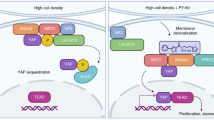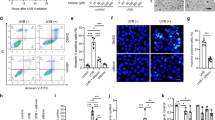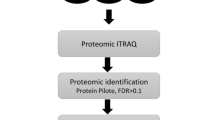Abstract
Retinoids are widely used in diseases spanning from dermatological lesions to cancer, but exhibit severe adverse effects. A novel all-trans-Retinoic Acid (atRA)-spermine conjugate (termed RASP) has shown previously optimal in vitro and in vivo anti-inflammatory and anticancer efficacy, with undetectable teratogenic and toxic side-effects. To get insights, we treated HaCaT cells which resemble human epidermis with IC50 concentration of RASP and analyzed their miRNA expression profile. Gene ontology analysis of their predicted targets indicated dynamic networks involved in cell proliferation, signal transduction and apoptosis. Furthermore, DNA microarrays analysis verified that RASP affects the expression of the same categories of genes. A protein–protein interaction map produced using the most significant common genes, revealed hub genes of nodal functions. We conclude that RASP is a synthetic retinoid derivative with improved properties, which possess the beneficial effects of retinoids without exhibiting side-effects and with potential beneficial effects against skin diseases including skin cancer.
This is a preview of subscription content, access via your institution
Access options
Subscribe to this journal
Receive 6 print issues and online access
$259.00 per year
only $43.17 per issue
Buy this article
- Purchase on Springer Link
- Instant access to full article PDF
Prices may be subject to local taxes which are calculated during checkout






Similar content being viewed by others
References
Beckenbach L, Baron JM, Merk HF, Löffler H, Amann PM. Retinoid treatment of skin diseases. Eur J Dermatol. 2015;25:384–91.
Estler M, Boskovic G, Denvir J, Miles S, Primerano DA, Niles RM. Global analysis of gene expression changes during retinoic acid-induced growth arrest and differentiation of melanoma: comparison to differentially expressed genes in melanocytes vs melanoma. BMC Genomics. 2008;9:478.
Szymański Ł, Skopek R, Palusińska M, Schenk T, Stengel S, Lewicki S, et al. Retinoic acid and its derivatives in skin. Cells. 2020;9:2660.
Ferreira R, Napoli J, Enver T, Bernardino L, Ferreira L. Advances and challenges in retinoid delivery systems in regenerative and therapeutic medicine. Nat Commun. 2020;11:4265.
Schoop VM, Fusenig NE, Mirancea N. Epidermal organization and differentiation of HaCaT keratinocytes in organotypic coculture with human dermal fibroblasts. J Invest Dermatol. 1999;112:343–53.
Breitkreutz D, Stark H-J, Plein P, Baur M, Fusenig NE. Differential modulation of epidermal keratinization in immortalized (HaCaT) and tumorigenic human skin keratinocytes (HaCaT-ras) by retinoic acid and extracellular Ca2+. Differentiation. 1993;54:201–17.
Tang X-H, Gudas LJ. Retinoids, retinoic acid receptors, and cancer. Annu Rev Pathol Mech Dis. 2011;6:345–64.
Hu XT, Zuckerman KS. Role of cell cycle regulatory molecules in retinoic acid- and vitamin D3-induced differentiation of acute myeloid leukaemia cells. Cell Prolif. 2014;47:200–10.
Huang ME, Ye YC, Chen SR, Chai JR, Lu JX, Zhoa L, et al. Use of all-trans retinoic acid in the treatment of acute promyelocytic leukemia. Blood. 1988;72:567–72.
Lin E, Chen M-C, Huang C-Y, Hsu S-L, Huang WJ, Lin M-S, et al. All-trans retinoic acid induces DU145 cell cycle arrest through Cdk5 activation. Cell Physiol Biochem. 2014;33:1620–30.
Zhang M-l, Tao Y, Zhou W-Q, Ma P-C, Cao Y-P, He C-D, et al. All- trans retinoic acid induces cell-cycle arrest in human cutaneous squamous carcinoma cells by inhibiting the mitogen-activated protein kinase-activated protein 1 pathway. Clin Exp Dermatol. 2014;39:354–60.
Schenk T, Stengel S, Zelent A. Unlocking the potential of retinoic acid in anticancer therapy. Br J Cancer. 2014;111:2039–45.
Al-Qassab Y, Grassilli S, Brugnoli F, Vezzali F, Capitani S, Bertagnolo V. Protective role of all-trans retinoic acid (ATRA) against hypoxia-induced malignant potential of non-invasive breast tumor derived cells. BMC Cancer. 2018;18:1194.
Albers M, Kranz H, Kober I, Kaiser C, Klink M, Suckow J, et al. Automated yeast two-hybrid screening for nuclear receptor-interacting proteins. Mol Cell Proteom. 2005;4:205–13.
Amoutzias GD, Pichler EE, Mian N, De Graaf D, Imsiridou A, Robinson-Rechavi M, et al. A protein interaction atlas for the nuclear receptors: properties and quality of a hub-based dimerisation network. BMC Syst Biol. 2007;1:34.
Browne H, Mason G, Tang T. Retinoids and pregnancy: an update. Obstet Gynaecol. 2014;16:7–11.
Ni X, Hu G, Cai X. The success and the challenge of all-trans retinoic acid in the treatment of cancer. Crit Rev Food Sci Nutr. 2019;59:S71–S80.
Magoulas G, Papaioannou D, Papadimou E, Drainas D. Preparation of spermine conjugates with acidic retinoids with potent ribonuclease P inhibitory activity. Eur J Med Chem. 2009;44:2689–95.
Vourtsis D, Lamprou M, Sadikoglou E, Giannou A, Theodorakopoulou O, Sarrou E, et al. Effect of an all-trans-retinoic acid conjugate with spermine on viability of human prostate cancer and endothelial cells in vitro and angiogenesis in vivo. Eur J Pharm. 2013;698:122–30.
Hadjipavlou-Litina D, Magoulas GE, Bariamis SE, Drainas D, Avgoustakis K, Papaioannou D. Does conjugation of antioxidants improve their antioxidative/anti-inflammatory potential? Bioorg Med Chem. 2010;18:8204–17.
Petridis T, Giannakopoulou D, Stamatopoulou V, Grafanaki K, Kostopoulos CG, Papadaki H, et al. Investigation on toxicity and teratogenicity in rats of a retinoid-polyamine conjugate with potent anti-inflammatory properties. Birth Defects Res Part B Dev Reprod Toxicol. 2016;107:32–44.
Lee D-D, Stojadinovic O, Krzyzanowska A, Vouthounis C, Blumenberg M, Tomic-Canic M. Retinoid-responsive transcriptional changes in epidermal keratinocytes. J Cell Physiol. 2009;220:427–39.
Lima L, de Melo TCT, Marques D, de Araújo JNG, Leite ISF, Alves CX, et al. Modulation of all-trans retinoic acid-induced MiRNA expression in neoplastic cell lines: a systematic review. BMC Cancer. 2019;19:866.
Gholikhani-Darbroud R. MicroRNA and retinoic acid. Clin Chim Acta. 2020;502:15–24.
Bariamis SE, Magoulas GE, Grafanaki K, Pontiki E, Tsegenidis T, Athanassopoulos CM, et al. Synthesis and biological evaluation of new C-10 substituted dithranol pleiotropic hybrids. Bioorg Med Chem. 2015;23:7251–63.
Skeparnias I, Anastasakis D, Grafanaki K, Kyriakopoulos G, Alexopoulos P, Dougenis D, et al. Contribution of miRNAs, tRNAs and tRFs to aberrant signaling and translation deregulation in lung cancer. Cancers. 2020;12:3056.
Theofilatos K, Dimitrakopoulos C, Likothanassis S, Kleftogiannis D, Moschopoulos C, Alexakos C, et al. The human interactome knowledge base (HINT-KB): an integrative human protein interaction database enriched with predicted protein–protein interaction scores using a novel hybrid technique. Artif Intell Rev. 2014;42:427–43.
Shannon P. Cytoscape: a software environment for integrated models of biomolecular interaction networks. Genome Res. 2003;13:2498–504.
Li M, Li D, Tang Y, Wu F, Wang J. CytoCluster: a cytoscape plugin for cluster analysis and vsualization of biological networks. Int J Mol Sci. 2017;18:1880.
Huang DW, Sherman BT, Lempicki RA. Systematic and integrative analysis of large gene lists using DAVID bioinformatics resources. Nat Protoc. 2009;4:44–57.
Wang Y, Zhang D. Tanshinol inhibits growth of malignant melanoma cells via regulating miR-1207-5p/CHPF pathway. Arch Dermatol Res. 2020;312:373–83.
Singhvi G, Manchanda P, Krishna Rapalli V, Kumar Dubey S, Gupta G, Dua K. MicroRNAs as biological regulators in skin disorders. Biomed Pharmacother. 2018;108:996–1004.
Gillespie J, Skeeles LE, Allain DC, Kent MN, Peters SB, Nagarajan P, et al. MicroRNA expression profiling in metastatic cutaneous squamous cell carcinoma. J Eur Acad Dermatol Venereol. 2016;30:1043–5.
Xiang M, Yuan W, Zhang W, Huang J. Expression of miR-490-5p, miR-148a-3p and miR-608 in bladder cancer and their effects on the biological characteristics of bladder cancer cells. Oncol Lett. 2019;17:4437–42.
Zhang J, Zhu Z, Sheng J, Yu Z, Yao B, Huang K, et al. miR-509-3-5P inhibits the invasion and lymphatic metastasis by targeting PODXL and serves as a novel prognostic indicator for gastric cancer. Oncotarget. 2017;8:34867–83.
Chen L, Lü M-H, Zhang D, Hao N-B, Fan Y-H, Wu Y-Y, et al. miR-1207-5p and miR-1266 suppress gastric cancer growth and invasion by targeting telomerase reverse transcriptase. Cell Death Dis. 2014;5:e1034.
Li X, Wu P, Tang Y, Fan Y, Liu Y, Fang X, et al. Down-regulation of MiR-181c-5p promotes epithelial-to-mesenchymal transition in laryngeal squamous cell carcinoma via targeting SERPINE1. Front Oncol. 2020;10:544476
Jin Z, Jia B, Tan L, Liu Y. miR-330-3p suppresses liver cancer cell migration by targeting MAP2K1. Oncol Lett. 2019;18:314–20.
Wang H, Liu G, Li T, Wang N, Wu J, Zhi H. MiR-330-3p functions as a tumor suppressor that regulates glioma cell proliferation and migration by targeting CELF1. Arch Med Sci. 2020;16:1166–75.
Li Y, Huang R, Wang L, Hao J, Zhang Q, Ling R, et al. microRNA-762 promotes breast cancer cell proliferation and invasion by targeting IRF7 expression. Cell Prolif. 2015;48:643–9.
Dever TE, Ivanov IP. Roles of polyamines in translation. J Biol Chem. 2018;293:18719–29.
Ishida S, Shigemoto-Mogami Y, Shinozaki Y, Kagechika H, Shudo K, Ozawa S, et al. Differential modulation of PI3-kinase/Akt pathway during all-trans retinoic acid- and Am80-induced HL-60 cell differentiation revealed by DNA microarray analysis. Biochem Pharm. 2004;68:2177–86.
Chen Q, Liu D, Hu Z, Luo C, Zheng SL. miRNA-101-5p inhibits the growth and aggressiveness of NSCLC cells through targeting CXCL6. Onco Targets Ther. 2019;12:835–48.
You W, Zhang X, Ji M, Yu Y, Chen C, Xiong Y, et al. MiR-152-5p as a microRNA passenger strand special functions in human gastric cancer cells. Int J Biol Sci. 2018;14:644–53.
Miao Y, Li Q, Sun G, Wang L, Zhang D, Xu H, et al. MiR‐5683 suppresses glycolysis and proliferation through targeting pyruvate dehydrogenase kinase 4 in gastric cancer. Cancer Med. 2020;9:7231–43.
Ayub SG, Kaul D, Ayub T. An androgen-regulated miR-2909 modulates TGFβ signalling through AR/miR-2909 axis in prostate cancer. Gene. 2017;631:1–9.
Wu J, Li J, Ren J, Zhang D. MicroRNA-485-5p represses melanoma cell invasion and proliferation by suppressing Frizzled7. Biomed Pharmacother. 2017;90:303–10.
Liu Y, Cheng Z, Pan F, Yan W. MicroRNA-373 promotes growth and cellular invasion in osteosarcoma cells by activation of the PI3K/AKT‐Rac1‐JNK pathway: the potential role in spinal osteosarcoma. Oncol Res Featur Preclin Clin Cancer Ther. 2017;25:989–99.
Bai X, Yang M, Xu Y. MicroRNA-373 promotes cell migration via targeting salt-inducible kinase 1 expression in melanoma. Exp Ther Med. 2018;16:4759–64.
Hong S, Yan Z, Wang H, Ding L, Song Y, Bi M. miR-663b promotes colorectal cancer progression by activating Ras/Raf signaling through downregulation of TNK1. Hum Cell. 2020;33:104–15.
Lu Y, Yang L, Qin A, Qiao Z, Huang B, Jiang X, et al. miR-1470 regulates cell proliferation and apoptosis by targeting ALX4 in hepatocellular carcinoma. Biochem Biophys Res Commun. 2020;522:716–23.
Miskin RP, Warren JSA, Ndoye A, Wu L, Lamar JM, DiPersio CM. Integrin α3β1 promotes invasive and metastatic properties of breast cancer cells through induction of the Brn-2 transcription factor. Cancers. 2021;13:480.
Song J, Zhang J, Wang J, Wang J, Guo X, Dong W. β1 integrin mediates colorectal cancer cell proliferation and migration through regulation of the Hedgehog pathway. Tumor Biol. 2015;36:2013–21.
Trojanowicz B, Winkler A, Hammje K, Chen Z, Sekulla C, Glanz D, et al. Retinoic acid-mediated down-regulation of ENO1/MBP-1 gene products caused decreased invasiveness of the follicular thyroid carcinoma cell lines. J Mol Endocrinol. 2009;42:249–60.
Valente P, Fassina G, Melchiori A, Masiello L, Cilli M, Vacca A, et al. TIMP-2 over-expression reduces invasion and angiogenesis and protects B16F10 melanoma cells from apoptosis. Int J Cancer. 1998;75:246–53.
Ratzinger S, Grässel S, Dowejko A, Reichert TE, Bauer RJ. Induction of type XVI collagen expression facilitates proliferation of oral cancer cells. Matrix Biol. 2011;30:118–25.
Yao H-S, Sun C, Li X-X, Wang Y, Jin K-Z, Zhang X-P, et al. Annexin A4-nuclear factor-κB feedback circuit regulates cell malignant behavior and tumor growth in gallbladder cancer. Sci Rep. 2016;6:31056.
Elias I, Ferré T, Vilà L, Muñoz S, Casellas A, Garcia M, et al. ALOX5AP overexpression in adipose tissue leads to LXA 4 production and protection against diet-induced obesity and insulin resistance. Diabetes. 2016;65:2139–50.
Silverbush D, Sharan R. A systematic approach to orient the human protein–protein interaction network. Nat Commun. 2019;10:3015.
Cardinez C, Miraghazadeh B, Tanita K, da Silva E, Hoshino A, Okada S, et al. Gain-of-function IKBKB mutation causes human combined immune deficiency. J Exp Med. 2018;215:2715–24.
Tetel MJ, Acharya KD. Nuclear receptor coactivators: regulators of steroid action in brain and behaviour. J Neuroendocrinol. 2013;25:1209–18.
Wiley JW, Higgins GA, Athey BD. Stress and glucocorticoid receptor transcriptional programming in time and space: Implications for the brain-gut axis. Neurogastroenterol Motil. 2016;28:12–25.
Korashy H, Abuohashish H, Maayah Z. The Role of Aryl Hydrocarbon Receptor-Regulated Cytochrome P450 Enzymes in Glioma. Curr Pharm Des. 2013;19:7155–66.
James Faresse N, Canella D, Praz V, Michaud J, Romascano D, Hernandez N. Genomic study of RNA polymerase II and III SNAPc-bound promoters reveals a gene transcribed by both enzymes and a broad use of common activators. PLoS Genet. 2012;8:e1003028.
Grafanaki K, Anastasakis D, Kyriakopoulos G, Skeparnias I, Georgiou S, Stathopoulos C. Translation regulation in skin cancer from a tRNA point of view. Epigenomics. 2019;11:215–45.
Haase M, Fitze G. HSP90AB1: helping the good and the bad. Gene. 2016;575:171–86.
Parruti G, Peracchia F, Sallese M, Ambrosini G, Masini M, Rotilio D, et al. Molecular analysis of human beta-arrestin-1: cloning, tissue distribution, and regulation of expression. Identification of two isoforms generated by alternative splicing. J Biol Chem. 1993;268:9753–61.
Acknowledgements
I. Skeparnias is supported by a fellowship from the “RIBOMAP” Grant implemented under the Operational Program: Human Resources Development, Education and Lifelong Learning which is co-funded by the European Social Fund (ESF) and National Resources (MIS 5047175 to C.S.). G. Kyriakopoulos is supported by a PhD fellowship from the INSPIRED (MIS 5002550), which is implemented under the Action “Reinforcement of the Research and Innovation Infrastructure”, funded by the Operational Program “Competitiveness, Entrepreneurship and Innovation” (NSRF 2014–2020) and co-financed by Greece and the European Union (European Regional Development Fund).
Funding
The work was supported by INSPIRED (MIS 5002550), which is implemented under the Action “Reinforcement of the Research and Innovation Infrastructure”, funded by the Operational Program “Competitiveness, Entrepreneurship and Innovation” (NSRF 2014–2020) and co-financed by Greece and the European Union (European Regional Development Fund).
Author information
Authors and Affiliations
Corresponding authors
Ethics declarations
Conflict of interest
The authors declare no competing interests.
Additional information
Publisher’s note Springer Nature remains neutral with regard to jurisdictional claims in published maps and institutional affiliations.
Supplementary information
Rights and permissions
About this article
Cite this article
Grafanaki, K., Skeparnias, I., Kontos, C.K. et al. Pharmacoepigenomics circuits induced by a novel retinoid-polyamine conjugate in human immortalized keratinocytes. Pharmacogenomics J 21, 638–648 (2021). https://doi.org/10.1038/s41397-021-00241-9
Received:
Revised:
Accepted:
Published:
Issue Date:
DOI: https://doi.org/10.1038/s41397-021-00241-9
This article is cited by
-
Synthesis, Spectroscopy and Crystal Structure Analysis of N1,N3-dicyclohexyl-N1-(all-trans-retinoyl)urea
Journal of Chemical Crystallography (2022)



